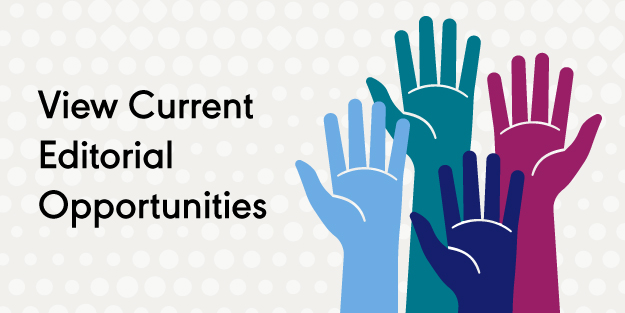Editorial Board Roles and Opportunities
Each ASHA journal features an editorial board with the following roles:
- Editor-in-chief
- Editor
- Editorial board member
The number of editors and editorial board members for each journal varies and is a function of the number of submissions over the preceding 2 years. At present, AJA, AJSLP, JSLHR, and LSHSS have a combined total of 7 editors-in-chief (one for each journal or journal section), 40 editors, and 175 editorial board members. Perspectives of the ASHA Special Interest Groups will has 4 editors-in-chief, 19 editors (one for each SIG) and 176 editorial board members. Duties and qualifications for these roles, as well as information on expressing interest to serve on an editorial board, are detailed in the sections below.
With each journal or section guided by an editor-in-chief, the goal is to empower highly experienced scientists who have a larger vision for the field to shape and adjust the journal to best meet the ever-evolving needs of the readership. The editors-in-chief are also in the optimal position to have broad oversight of the review process. In this model, editors are empowered to make final editorial decisions on submissions on the basis of structured reviews and recommendations from committed expert reviewers who are editorial board members.
Current Opportunities
The ASHA Journals regularly look to fill open positions on the editorial boards. Use the button below to view current open positions or use the link in the Quick Resources sidebar to submit an Expression of Interest form to indicate your interest to serve in the future if applications are not currently being taken.
Current Editorial Board Rosters
In addition to being listed by role on the rosters for each journal linked below, participants on the editorial boards are included in a masthead article published in each journal. This helps ensure that there is a historical and clear record of everyone’s involvement.
ASHA Journals Board
The Journal’s Board provides strategic oversight to ASHA’s journals program. As such, the board is charged with (a) approving editors and editorial board members for the ASHA scholarly journals, (b)conducting ongoing strategic planning for the program, and (c) monitoring and ensuring the effective functioning of the editors and editorial board. The board is composed of the following members
- Chair
- 7 Editors-in-Chief (AJA, 2 AJSLP, JSLHR-Speech, JSLHR-Language, JSLHR-Hearing, LSHSS)
- 4 Editors-in-Chief from Perspectives of the ASHA Special Interest Groups (as of 2019)
- Representative from the standing committee on Clinical Practice Research, Implementation Science, and Evidence-Based Practice (CRISP)
- International Representative
- Ex Officio
- Vice President for Science & Research (Board of Directors liaison)
The editors–in-chief are selected and appointed by the Journals Board. The other members of the Journals Board are approved by ASHA’s Committee on Nominations and Elections.
ASHA's New Editorial Board Model
Sumitrajit (Sumit) Dhar, professor and chair of the Department of Communication Sciences and Disorders at Northwestern University and editor-in-chief of the American Journal of Audiology, describes the new editorial board model that ASHA journals started implementing January 1, 2017.
Why Serve as a Peer Reviewer?
Sumitrajit (Sumit) Dhar, professor and chair of the Department of Communication Sciences and Disorders at Northwestern University, discusses the benefits of serving as a peer reviewer and encourages people to get involved in peer review.








